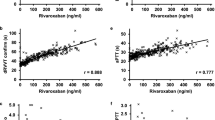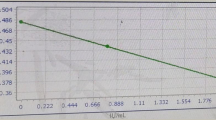Abstract
Because of the possible interference of antiphospholipid antibodies (APL) with the phospholipid component of thromboplastin reagents, concerns have been raised about the validity of international normalized ratio (INR) testing to monitor anticoagulant therapy with vitamin K antagonists in patients with antiphospholipid syndrome (APS). To investigate the reliability of the INR, we determined the INR using various prothrombin time (PT) assays and compared the results with those of a chromogenic factor X (CFX) assay. The study cohort consisted of 40 APS patients and 100 APL-negative patients who were on anticoagulant therapy for reasons other than APS. The agreement (i.e. the percentage of patients with a difference ≤0.5 INR units) between the PT-derived INR and CFX-derived INR equivalents was only moderate in both patient groups. The best agreement with CFX-derived INR equivalents was observed for the Thromborel S reagent in APS patients (69.1 %) and for Neoplastin Plus in APL-negative patients (72.0 %). Regarding the results for the point-of-care system CoaguChek XS, an agreement between the INR and the CFX-derived INR equivalent was less frequently observed in the APS patients (55.6 vs. 67.8 %; p = 0.050). When considering all 3058 pairs of INR tests within the international sensitivity index (ISI)-calibrated range of 1.5 to 4.5 s, we did not observe a higher variability of INR values in either the APS patient group or the subgroup of APS patients positive for lupus coagulants compared with the APL-negative controls. In conclusion, monitoring vitamin K antagonists (VKA) therapy with laboratory INR measurements seems to be suitable for the majority of APS patients.

Similar content being viewed by others
References
Du VX, Kelchtermans H, de Groot PG, de Laat B (2013) From antibody to clinical phenotype, the black box of the antiphospholipid syndrome: pathogenic mechanisms of the antiphospholipid syndrome. Thromb Res 132:319–326
Favaloro EJ, Wong RC (2011) Laboratory testing for the antiphospholipid syndrome: making sense of antiphospholipid antibody assays. Clin Chem Lab Med 49:447–461
Pengo V, Ruffatti A, Legnani C, Gresele P, Barcellona D, Erba N et al (2010) Clinical course of high-risk patients diagnosed with antiphospholipid syndrome. J Thromb Haemost 8:237–242
Favaloro EJ, McVicker W, Hamdam S, Hocker N (2010) Improving the harmonisation of the international normalized ratio (INR): time to think outside the box? Clin Chem Lab Med 48:1079–1090
WHO Expert Committee on Biological Standardization (1999) Guidelines for thromboplastins and plasma used to monitor oral anticoagulant therapy. World Health Organization Technical Report Series; no. 889. Geneva, WHO
Crowther M, Crowther MA (2010) Intensity of warfarin coagulation in the antiphospholipid syndrome. Curr Rheumatol Rep 12:64–69
Keeling D, Mackie I, Moore GW, Greer IA, Greaves M, Committee B, British Committee for Standards in Haematology (2012) Guidelines on the investigation and management of antiphospholipid syndrome. Br J Haematol 157:47–58
Poller L (2004) International normalized ratios (INR): the first 20 years. J Thromb Haemost 2:849–860
Smith SA, Comp PC, Mirrissey JH (2006) Phospholipid composition controls thromboplastin sensitivity to individual clotting factors. J Thromb Haemost 4:820–827
Robert A, Le Querrec A, Delahousse B, Caron C, Houbouyan L, Boutière B et al (1998) Control of oral anticoagulation in patients with the antiphospholipid syndrome – influence of the lupus anticoagulant on international normalized ratio. Thromb Haemost 80:99–103
Rosborough TK, Shepherd MF (2004) Unreliability of international normalized ratio for monitoring warfarin therapy in patients with lupus anticoagulant. Pharmacotherapy 24:838–842
Lawrie AS, Purdy G, Mackie IJ, Machin SJ (1997) Monitoring oral anticoagulation therapy in lupus anticoagulant positive patients with the anti-phospholipid syndrome. Br J Haematol 98:887–892
Bijsterveld NR, Middeldorp S, Berends F, Büller HR (2000) Monitoring therapy with vitamin K antagonists in patients with lupus anticoagulants: effect on different tests for INR determination. J Thromb Thrombolysis 9:263–269
Tripodi A, Chantarangkul V, Clerici M, Negri B, Galli M, Mannucci PM (2001) Laboratory control of oral anticoagulant treatment by the INR system in patients with the antiphospholipid syndrome and lupus anticoagulant. Results of a collaborative study involving nine commercial thromboplastins. Br J Haematol 115:672–678
Crowl A, Schullo-Feulner A, Moon JY (2014) Warfarin monitoring in antiphospholipid syndrome and lupus anticoagulant. Ann Pharmacother 48:1479–1483
Plesch W, Wolf T, Breitenbeck N, Dikkeschei LD, Cervero A, Perez PL et al (2008) Results of the performance verification of the CoaguChek XS system. Thromb Res 123:381–389
Pengo V, Tripodi A, Reber G, Rand JH, Ortel TL, Galli M et al (2009) Update of the guidelines for lupus anticoagulant detection. Subcommittee on Lupus Anticoagulant/Antiphospholipid Antibody of the Scientific and Standardisation Committee of the International Society on Thrombosis and Haemostasis. J Thromb Haemost 7:1737–1740
Brandt JT, Triplett DA, Alving B, Scharrer I (1995) Criteria for the diagnosis of lupus anticoagulants: an update. On behalf of the Subcommittee on Lupus Anticoagulant/Antiphospholipid Antibody of the Scientific and Standardisation Committee of the ISTH. Thromb Haemost 74:1185–1190
Miyakis S, Lockshin MD, Atsumi T, Branch DW, Brey RL, Cervera R et al (2006) International consensus statement on an update of the classification criteria for definite antiphospholipid syndrome (APS). J Thromb Haemost 4:295–306
McGlasson DL, Romick BG, Rubal BJ (2008) Comparison of a chromogenic factor X assay with international normalized ratio for monitoring oral anticoagulation therapy. Blood Coagul Fibrinolysis 19:513–517
Baumann Kreuziger LM, Datta YH, Johnson AD, Zantek ND, Shanley R, Reding MT (2014) Monitoring anticoagulation in patients with an unreliable prothrombin time/international normalized ratio: factor II versus chromogenic factor X testing. Blood Coagul Fibrinolysis 25:232–236
Della Valle P, Crippa L, Garlando AM, Pattarini E, Safa O, D’Angelo V et al (1999) Interference of lupus anticoagulants in prothrombin time assays: implications for selection of adequate methods to optimize the management of thrombosis in antiphospholipid-antibody syndrome. Haematologica 84:1065–1074
Rosborough TK, Jacobsen JM, Shepherd MF (2009) Relationship between chromogenic factor X and international normalized ratio differs during early warfarin initiation compared with chronic warfarin administration. Blood Coagul Fibrinolysis 20:433–435
Remijn JA, Lucas S, Wildeboer B, van Suijlen JD, Adriaansen HJ (2008) Strongly increased international normalized ratio with recombinant Neoplastin R compared with tissue extract Neoplastin Plus in patients initiating oral anticoagulation therapy: implications for anticoagulation dosage. Clin Chem 54:1929–1931
Remijn JA, Wildeboer B, van Suijlen JDE, Adiaansen HJ (2011) Recombinant thromboplastins vs. tissue-extract thromboplastins in patients on unstable oral anticoagulant therapy. Clin Chem 57:916–917
Solvik UO, Roraas TH, Petersen PH, Stavelin AV, Monsen G, Sandberg S (2012) Effect of coagulation factors on discrepancies in international normalized ratio results between instruments. Clin Chem Lab Med 50:1611–1620
Carrasco C, Campbell B, Shiach C (2004) Effects of the lupus anticoagulant on the control of oral anticoagulant treatment. Br J Haematol 124:555–563
Shermock KM, Streiff MB, Pinto BL, Kraus P, Pronovost PJ (2011) Novel analysis of clinically relevant diagnostic errors in point-of-care devices. J Thromb Haemost 9:1769–1775
Barcellona D, Fenu L, Vannini ML, Piras M, Marongiu F (2012) Antiphospholipid syndrome patients: the performance of CoaguChek XS in monitoring of vitamin K antagonists. Thromb Res 129:e168–e170
Christensen TD, Larsen TB, Jensen C, Maegaard M, Sorensen B (2009) International normalized ratio (INR) measured on the CoaguChek S and XS compared with the laboratory for determination of precision and accuracy. Thromb Haemost 101:563–569
Heneghan C, Alonso-Coello P, Garcia-Alamino JM, Perera R, Meats E, Glasziou P (2006) Self-monitoring of oral anticoagulation: a systemic review and meta-analysis. Lancet 367:404–411
Christensen TD, Johnsen SP, Hjortdal VE, Hasenkam JM (2007) Self-management of oral anticoagulant therapy: a systemic review and meta-analysis. Int J Cardiol 118:54–61
Schulman S, Kearon C, on behalf of the subcommittee on control of anticoagulation of the Scientific and Standardization committee of the International Society on Thrombosis and Haemostasis (2005) Definition of major bleeding in clinical investigations of antihemostatic medicinal products in non-surgical patients. Scientific and Standardization Committee Communication. J Thromb Haemost 3:692–694
National Kidney Foundation (2002) K/DOQI clinical practice guidelines for chronic kidney disease: evaluation, classification, and stratification. Am J Kidney Dis 39(2 Suppl 1):S1–S266
Conflict of interest
The authors declare that they have no conflict of interest.
Author information
Authors and Affiliations
Corresponding author
Rights and permissions
About this article
Cite this article
Isert, M., Miesbach, W., Schüttfort, G. et al. Monitoring anticoagulant therapy with vitamin K antagonists in patients with antiphospholipid syndrome. Ann Hematol 94, 1291–1299 (2015). https://doi.org/10.1007/s00277-015-2374-3
Received:
Accepted:
Published:
Issue Date:
DOI: https://doi.org/10.1007/s00277-015-2374-3




